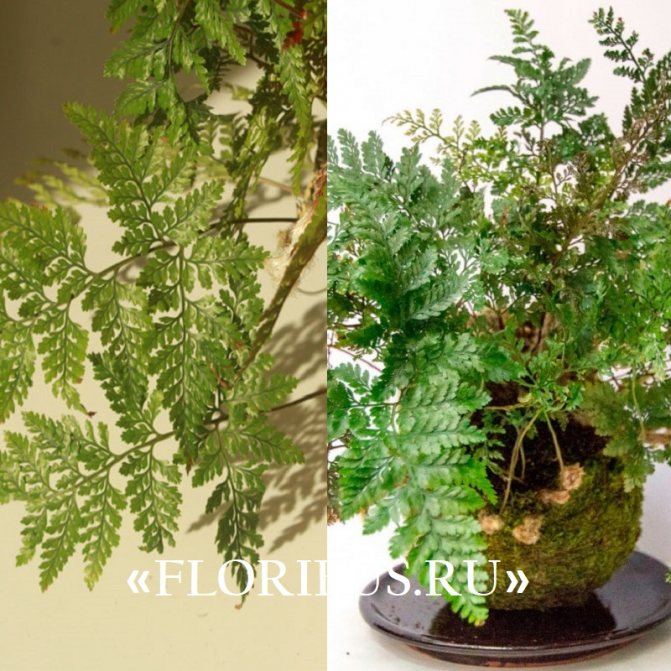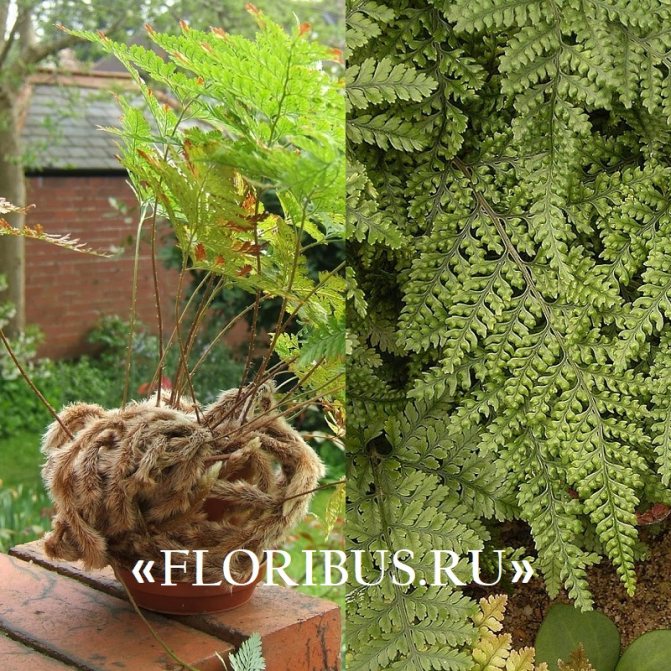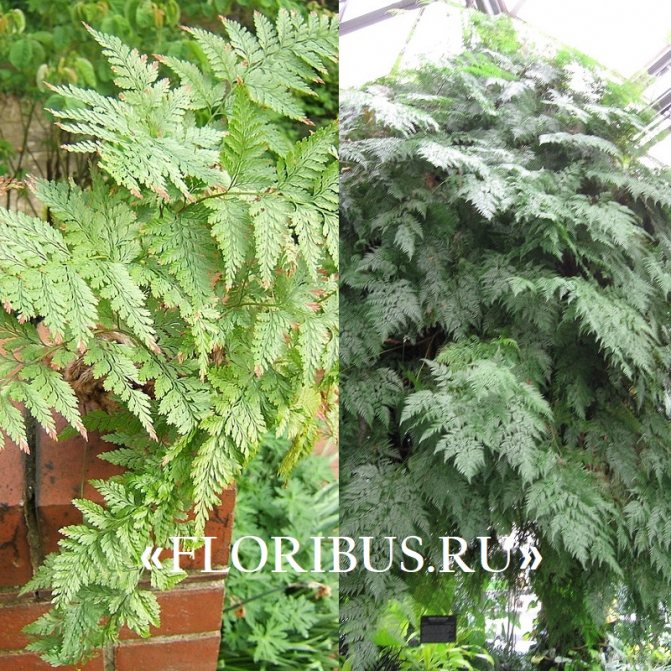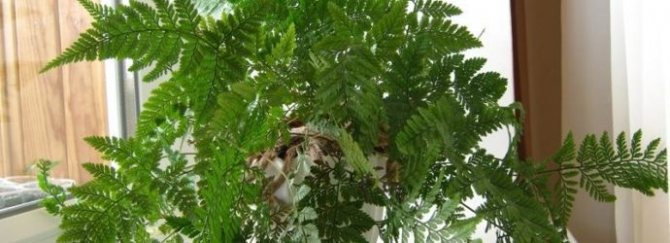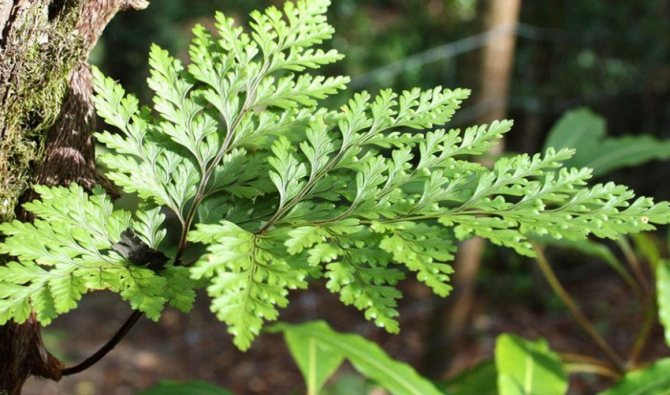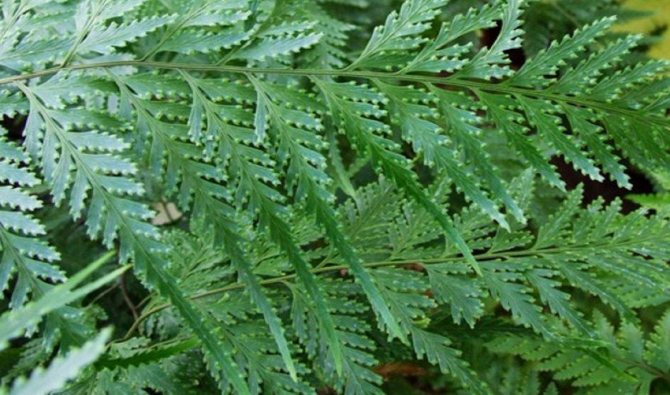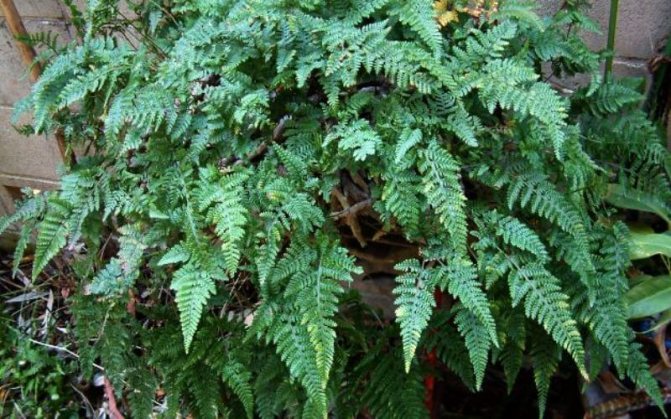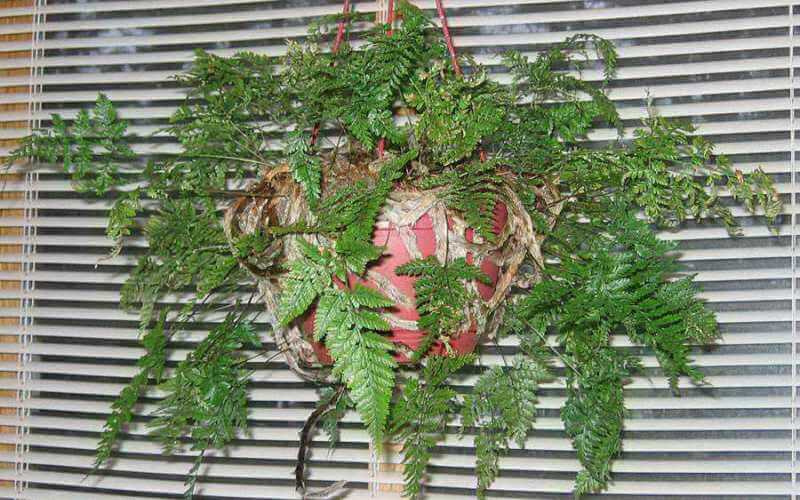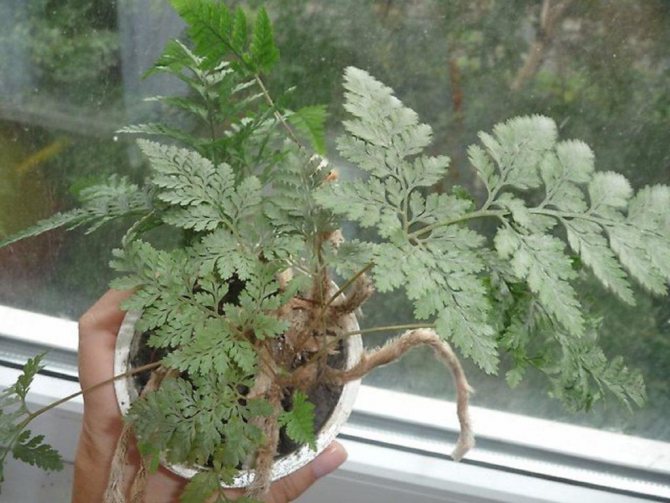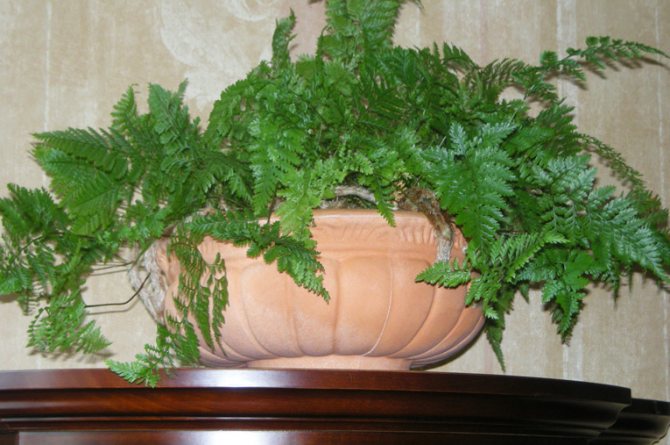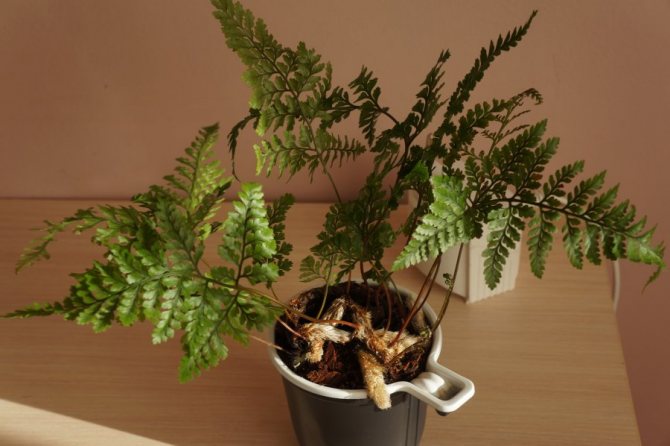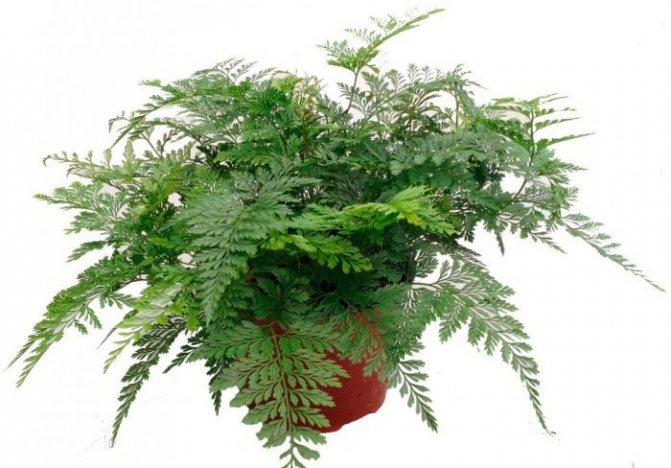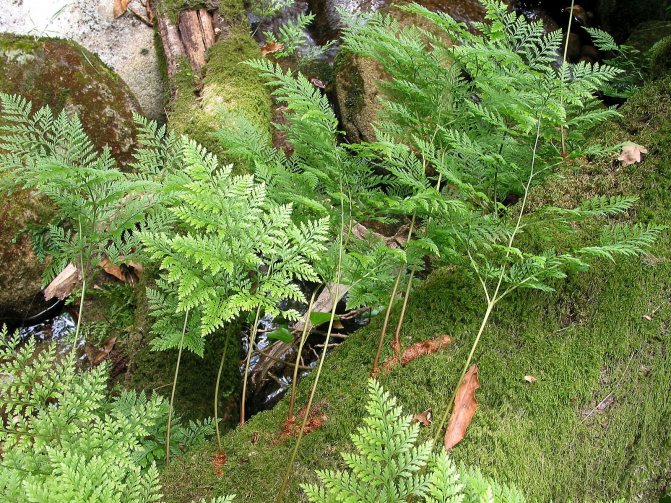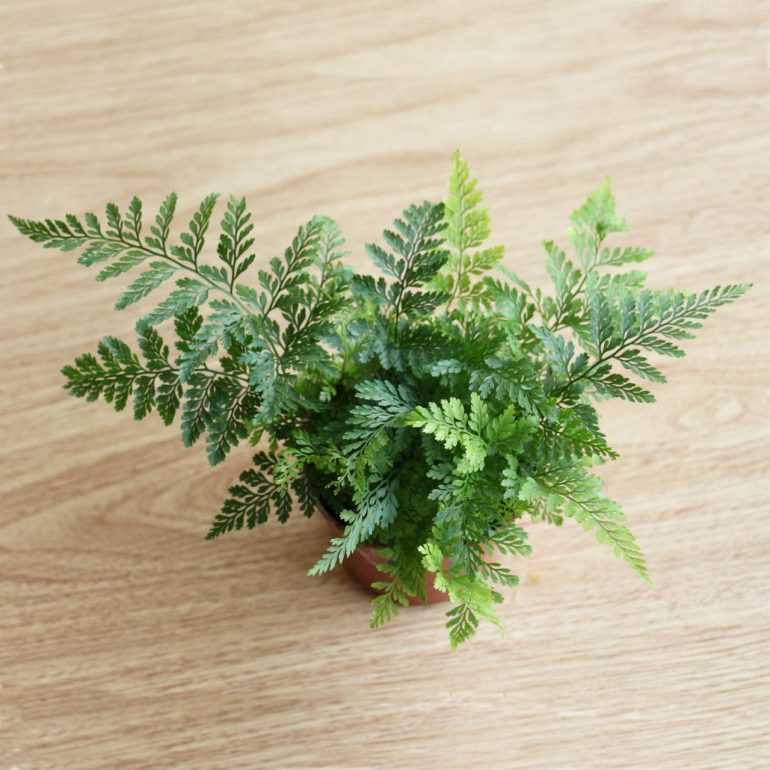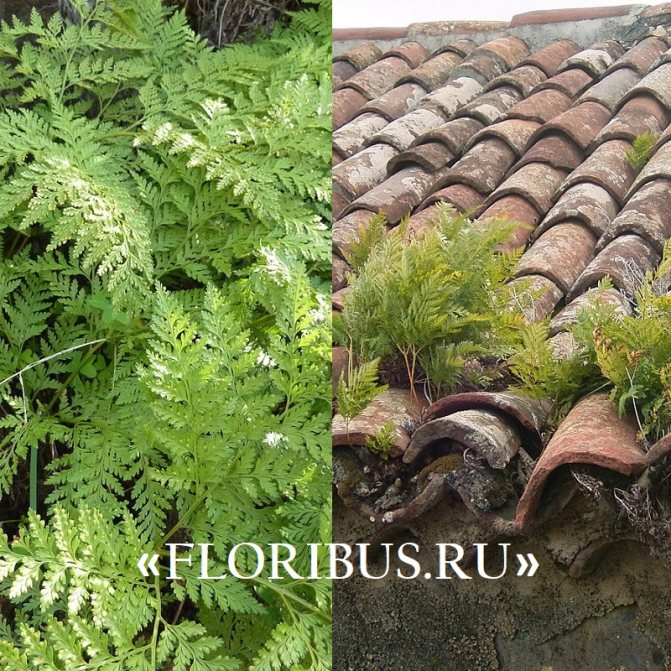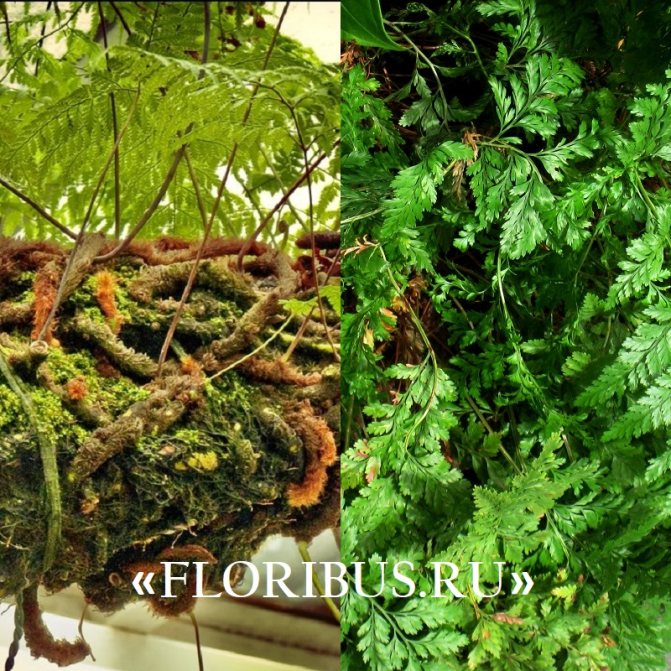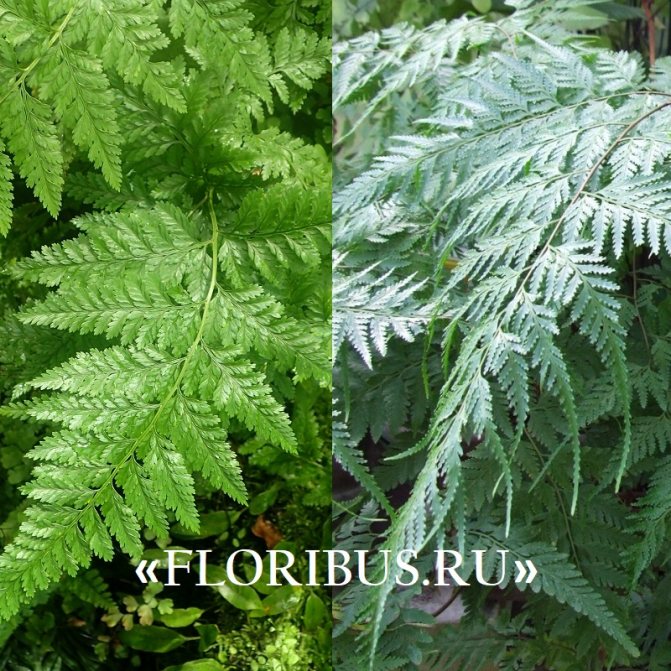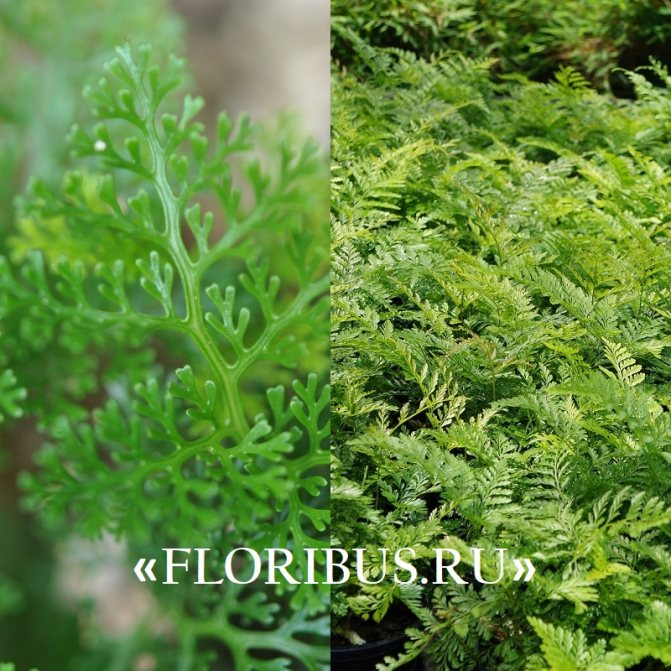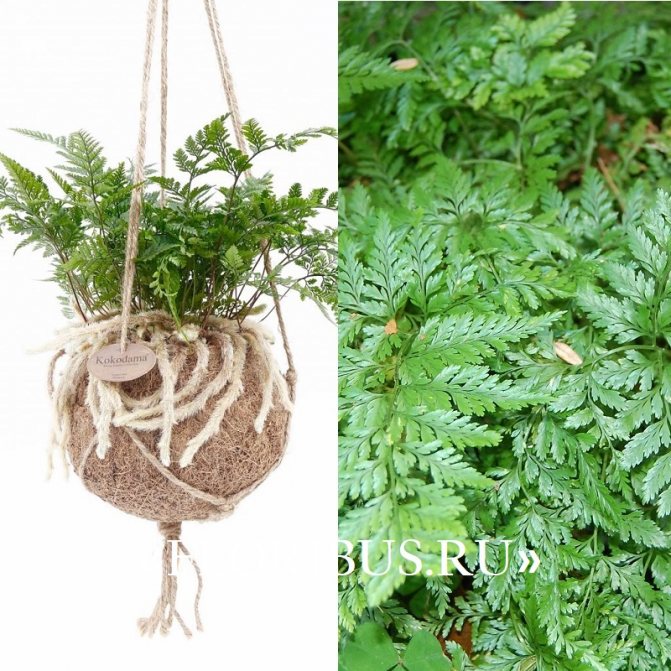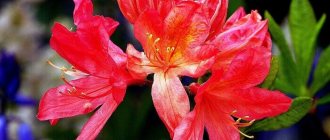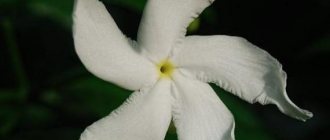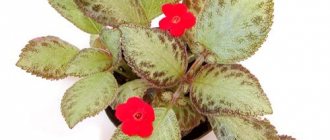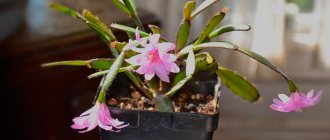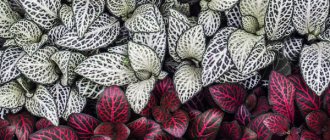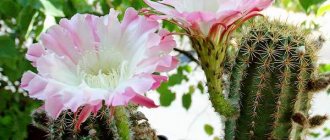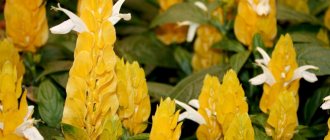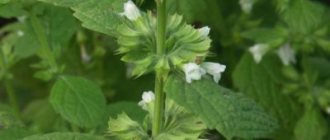The fern got its name thanks to the famous botanist E. Davallu.
Home-grown davaliya species, fern photos
Among the huge variety of davallia species, very few of them are cultivated:
- Davallia Canary, in Latin called Davallia canariensis, or Trichomanes Canary, otherwise Trichomanes canariensis is the most popular epiphytic variety from the Canary Islands, also living in North Africa and the Iberian Peninsula. This is a plant with a rhizome up to 15 cm long, with petioles and leaves of the same length - about 30 cm. The fronds of this species are four times pinnately dissected, rhomboid, elongated, with tightly attached lobes, very delicate.
- Davallia dense, called Davallia solida in Latin, is an epiphyte from Australia, Polynesia, from the Malay Archipelago, with long petioles, a double-feathery leaf plate in the form of a wide triangle, about 40 cm long and up to 20 cm wide.This Davallia is not as delicate as the Canary one, from - for the lobed structure of the shares.
- Davallia bladder, called Davallia bullata in Latin, is a species from Japan and China, interesting for its compact size - only about 15 cm high - and wayami, like that of dense davallia.
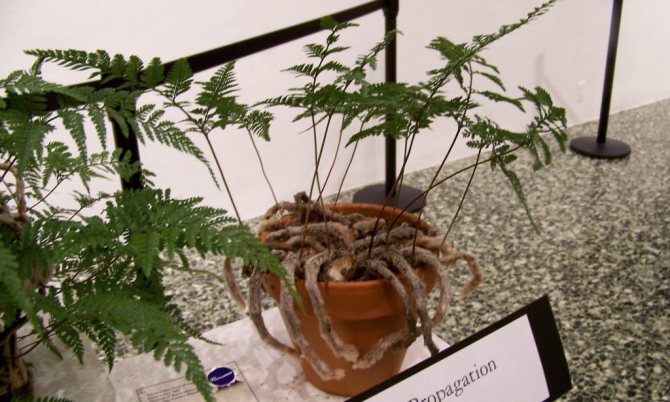
Photo. Davallia
Description of davallia
Davallia (lat.Davallia) - a genus of perennial fast-growing, exotic-looking ferns of the Davalliaceae family. The natural area of distribution is located mainly in tropical Asia, found in China, Japan, Polynesia and on the island of Java, in the Canary Islands.
Some species are widespread in culture, cultivated indoors, usually in greenhouses, often cacampal plants.
The popular name for this fern is "hare feet", sometimes "squirrel feet", or "deer leg", which is usually called the most popular species in decorative floriculture - Davallia Canary.
Davalia is one of the most exotic looking, fast-growing ferns. Often the choice falls on her when choosing plants for wet rooms.
Several species are grown as indoor plants, for example, Davallia dissecta, Davallia trichomanoides, Davallia trichomanoides, Davallia truncatula, Davallia pentaphylla - all of them are epiphytic ferns with a thick rhizome of substrater covered with dense pubescence.
In greenhouses, where tropical plants are grown, D. bullata is always present - gnarled davallia - growing in tropical regions of Asia. In flower shops, it is very rare, since it is difficult to create high air humidity in room conditions.Since davallia is an epiphytic plant, it is attached to pieces of bark, to which thick rhizomes, covered with red-brown or silvery scales, cling to.
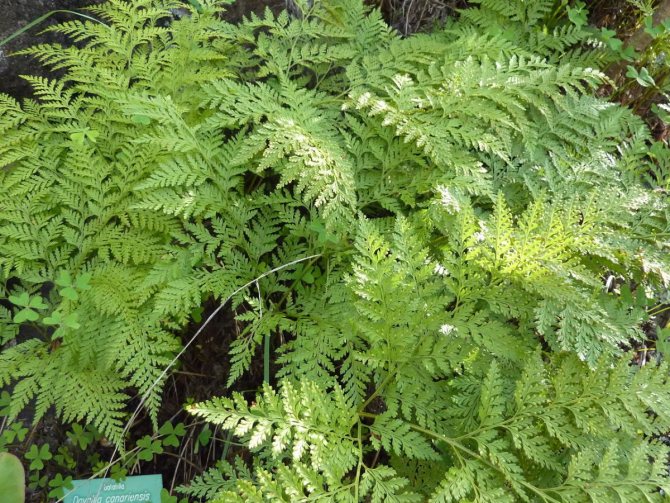

Davallia canary (Davallia canariensis).
Choosing a location for davallia
Place the dawallia in a place where there is diffused light.
The davallia fern prefers a sunny place with diffused light and no direct sunlight. The best summer option is an east-facing window, where light enters mainly in the morning, or a north-west window. In the south or west, the fern will need shading, and in the north, it will suffer from a lack of light.
The best temperature for a plant in summer is 18 to 22 ° C, and in winter 15 ° C or more. It is important to remember that davallia does not tolerate drafts. If the temperature is too low, the plant can shed all the leaves, but in this case there is a chance that it will grow new ones in the spring.
What do you need for successful growth?
For the safe cultivation of davallia, it is necessary to carry out the correct planting and care in accordance with her preferences. And you need to start by choosing a favorable location and lighting.
Where to place the dawallia, the choice of lighting
This plant is very light-requiring, so the place for its placement must be chosen as light as possible. In this case, the flower should be protected from direct sunlight, in order to avoid burns and yellowing of the leaves.
If a window sill is intended for davallia, then a window facing east is best suited, where the sun will only have access in the morning.
A fern can grow in light shade, but at the same time it will somewhat lose its decorative qualities, and it will also grow more slowly.
It is possible to grow a plant under artificial lighting - davallia feels good under a fluorescent lamp.
Air humidity and temperature for davalia
The hare's feet fern is very picky about air humidity, so many of the species of this flower are practically not amenable to growing in an apartment, since it is impossible to organize the necessary humidity regime for them.
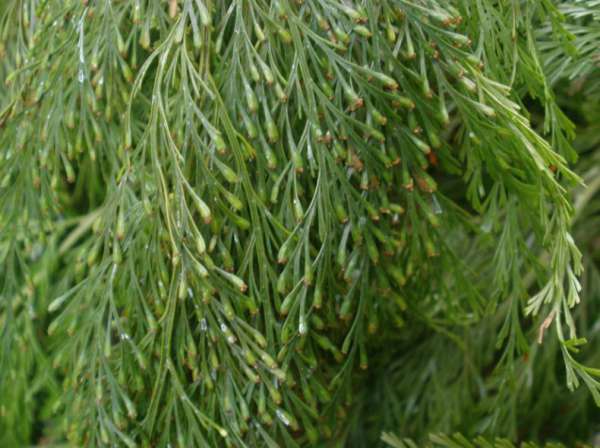

And even for most representatives of indoor species, the optimal humidity level will be 60-70%. Only davallia canary is less demanding on this indicator.
The fern is also picky about the temperature - in summer it feels good at 18-22 ° С, in winter it prefers rooms with temperatures no higher than 15-18 ° С. It can withstand temperatures down to 13 ºС, but not lower. If the plant is too cold, it will begin to shed its leaves. The fern must be protected from drafts.
Growing soil
For growing these ferns at home, a substrate from the composition is suitable: deciduous humus, peat, sand in equal proportions. It is advisable to add sphagnum, charcoal and a small amount of pine bark to it.
For planting, shop soil with about, "for bromylium" is also suitable.
The pot for planting must be chosen wide, always with a drainage hole. The bottom of the pot should be covered with good drainage.


Air humidity and watering
Despite the fact that the davallia flower is not afraid of dry air, it will still rejoice if the air humidity in the room is high. In this case, you can expect the appearance of a large number of new fronts.
In summer, the plant will enjoy living in the garden, on the terrace, balcony or veranda. Davallia gratefully responds to spraying with very fine sprays, and its hairy roots should be protected from drying out.
Attention - To increase the humidity around the flower, there is an excellent method - you need to put the container with the plant on a tray filled with damp pebbles, however, pebbles and water should not touch the bottom of the pot so that the soil is not constantly waterlogged.
Watering is best done with well-settled, slightly warm water.In the summer, the fern requires abundant watering with a constantly damp earthy clod, and in the winter - moderate. In case of loss of most of the leaves during the dormant period, watering at this time is minimal, to prevent overdrying of the soil in the pot. A plant grown on a snag is watered by immersing its root part in a basin of water for 20 minutes. The liquid should not come into contact with the leaves.
Care
If the plant is purchased from a store or brought from another home, be sure to inspect it. Often, harmful insects or signs of disease can be found in a new indoor flower. It is worth immediately arranging the greenery of the shower with warm water and spilling the soil abundantly. Then, you need to process it as a preventive measure against pests and diseases.
Do not put davallia with other houseplants. She needs to be quarantined. Place for two weeks in a separate place from other plants. After 14 days, the fern can be transplanted into a looser pot.
Lighting
All types of davallia require bright diffused lighting. Direct sunlight damages delicate fern leaves... For comfortable growing, windows facing west and east are suitable. If there is such a need, you can place the flower in a dark place, but not for a long period. Otherwise, the plant stops developing.
Temperature regime
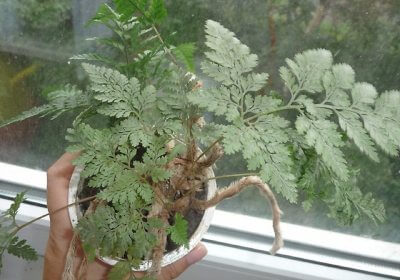

Davallia is dense and bubbly withstand temperatures of 17-25 ° C. Moreover, it is advisable to adhere to these values all year round. The lowered temperature regime causes a slowdown in growth and further death.
Canary dawallia, in winter, can tolerate a drop in temperature from 14 to 17 degrees. A kind of inhibition in the growing season makes it easier for the plant to overwinter.
Humidity and watering
For davallia, abundant watering is arranged. Use warm, soft, settled water. Do this moisturizing when the top layer of the earth dries up. In winter, it is worth reducing the amount of watering.... However, the fern is quite sensitive to the drying out of the substrate, this cannot be allowed.
Watering is preferably carried out using a watering can with a long spout. This is necessary so that moisture does not settle on overgrown roots hanging from all sides. It is good to use bottom watering.
All varieties of davallia ferns hardly tolerate dry air. To grow successfully, the humidity level in the room must be increased. Once a day, irrigate the leaves from a spray bottle with settled water. It is also good to put containers with indoor plants on flat trays with wet sand, peat. Canary dawallia is more resistant to dry air.
Top dressing
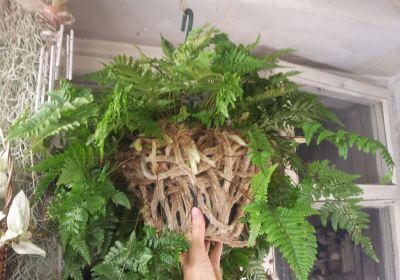

They bring useful substances under the roots, from spring to early autumn - April-September. For this, fertilizer is diluted for indoor ferns according to the scheme attached to the substance. Water once every 30 days.
With the onset of autumn cold weather and in winter, davallia does not need to be fed. Otherwise, there is a risk of root rot or the occurrence of serious diseases.
Transfer
It is advisable to transplant the fern during the growing season. This should be done only with a strong growth of rhizomes. It is worth taking a shallow pot for this purpose, because the root system of the plant is on the surface. It is better not to transplant in plastic containers, but to buy pots with holes. So the roots will be enriched with oxygen - "breathe".
Fern grown on a tree snag looks beautiful... An epiphyte (a plant that lives on another plant) is transplanted onto the surface of the bark. Lay coconut fiber or sphagnum moss on the snag or the bottom of the pot. Fix the seedling well to the wood. Roots, as they grow, tightly wrap around it from all sides. But this method does not fully moisturize davallia.
Priming
It is better to choose a substrate for planting a fern with a weak acidity.You can use peat, deciduous humus, river sand. Mix in equal parts. Buy containers with a wide top. At the bottom, be sure to put a drainage layer of expanded clay, broken clay shards. It is good when the substrate contains organic matter. For example, you can make a mixture like this:
- turf - 0.5 kg;
- a small bunch of moss;
- river sand - 0.5 kg;
- peat - 1 kg;
- humus from leaves - 1 kg;
- charcoal - 0.5 parts.
Fern transplant is done once every 2-3 years, in the spring.
Soil and fertilizer requirements
For a fern, the soil needs to be slightly acidic.
It is best to choose a slightly acidic soil substrate for the fern in question. You can compose it from:
- 1 part turf land
- 1 part sphagnum
- 1 part coarse sand
- 2 parts of peat land
- 2 pieces of leafy land
- Handfuls of charcoal
Another option that takes into account the epiphytic nature of the plant as much as possible (components are taken in equal proportions):
- Sphagnum moss, finely chopped
- Small pieces of pine bark
- Crumbled charcoal
- Purchased soil for bromeliads
- Peat
You can also grow davallia in orchid substrate.
Important - in no case should you remove the creeping roots of the fern.
It is best to feed the plant with fertilizer for decorative deciduous, diluted in half with water, only from May to August, once every two weeks, separately from watering.
Indoor ginura is an interesting plant for your home, detailed information on the link
You can find out how to grow indoor pomegranate here.
Reproduction and planting
For reproduction of the davallia fern, only vegetative methods are used. Spores only breed in the wild. It is very difficult to collect planting material of this type at home and growing from it can cause a lot of trouble. Therefore, for reproduction it is best to use daughter bushes, which are formed on the shoots of the roots or cuttings of the rhizome.
In the first case, young shoots are cut off along with the shoot. For planting, take a light substrate based on moss, sand and leafy soil. A shoot with a young bush is laid out in it, without burying it in the ground, in order to fix it in one position, expanded clay can be used. The soil needs to be moistened.
Fern transplant davallia
Davallia is transplanted only when the rhizome has grown strongly.
Spring transplantation of davallia into a slightly larger pot is required only when the rhizome has grown strongly and the plant has already become cramped in the container. Choose shallow, shallow pots - they are ideal for shallow davallia root systems. Often the flower is placed in wicker hanging baskets. Its rhizome "crawls" over the edge of the container and is located outside, under a lush cascade of foliage. For davallia, it is best to avoid plastic pots.
You can grow a fern in a tree hollow or on a decorative driftwood, placing the roots outside. However, in the last two cases, watering will be somewhat difficult. When planting, the bottom of the basket or hollow must be covered with coconut fiber or sphagnum. On the driftwood, the fern is fixed with a rope, covered with moss or coconut fiber.
Botanical description of the plant
A perennial plant up to 50 cm high, native to the tropical parts of Asia. A characteristic feature of these ferns is the shaggy roots that hang from the container.
Important! The botanical name was given in honor of the scientist-botanist of the XVIII century E. Davall, and due to the appearance of the roots, the fern is popularly known as "squirrel feet", "hare feet" or "deer leg".
The main features of davallia are presented in the table:
| Root system | superficial, with thick pubescent roots |
| Stem | short or medium |
| Leaf shape | fine-feathery, often triangular |
| Leaf color | from light to dark green |
The diameter of the roots can reach 15 mm, and some specimens reach a length of up to 90 cm. Davallias grow rapidly and are usually grown at home as an ampelous plant. This is how their exotic roots are most noticeable.
Fern breeding methods
Davallia reproduces in several ways.
If the grower needed another davallia, it can be propagated in several ways:
- Rhizome... Pieces of root with stems and fronds growing from them must be planted in a moist substrate by placing the "squirrel's feet" on the ground and lightly pressing them in or fixing them on the ground surface. After a while, young bushes will grow on the fluffy roots.
- By dividing the bush... This breeding method is carried out in the same way as described above. The only difference is that large parts of the bush are placed for rooting, divided for these purposes with a sharp knife. Slices must be sprinkled with crushed coal.
- Disputes... As you know, davallia does not bloom, but gives spores. If you dry them and plant them in disinfected peat soil, and then cover the container with polyethylene and place in a dark and warm place, after a while you can wait for shoots.
Important - When transplanting, you must not bury the roots of davallia, you just need to bury some of them slightly in the ground, or first immerse the roots in a pot, and then fill it with soil.
Reproduction
In their natural habitat, ferns breed with spores that grow in moist tropical soil. This method is not effective for a greenhouse or home collection. It is easier to get a new plant by splitting the root into parts.
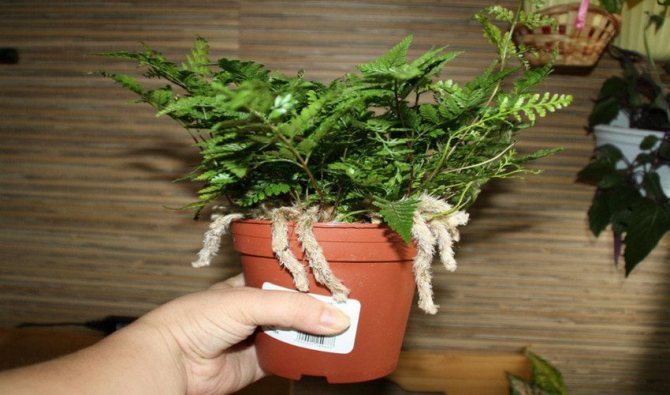

By dividing
The division takes place in April. To do this, the rhizome must be divided into parts so that 2 leaves remain on each of them. Such a seedling is laid on the surface of the substrate and pressed down with expanded clay.
It is necessary to maintain a high level of humidity, for which it is recommended to lightly cover the container with a bag after spraying. After 2 months, the plant should take root.
Disputes
Ripe spores are shaken off and dried, and then in May they are poured onto a damp peat or moss surface.
Important! Spores can cause allergic reactions!
For disinfection, sphagnum must be disinfected by steaming or calcining. The container with the inoculation is closed with a lid or tightened with foil. Spores germinate at temperatures between + 20 ° C and + 25 ° C. The sprouts are transplanted when they reach a height of 5 cm.
Diseases, pests and control methods
Root rot occurs in davallia due to excess moisture.
If the rules of care are violated, davallia can get sick:
- Root rot - from excessive watering. Rotten roots must be removed, the cuts must be sprinkled with charcoal. Next, the plant should be planted in fresh soil. To save the specimen, it is extremely important to establish proper care, and especially watering.
- Fungal or bacterial spotting... The diseased areas are cut out, the sections are sprinkled with ash. You can treat the plant with Mikosan.
Davallia is afraid of attack by pests such as:
- Whitefly
- Spider mite
- Mealybug
- Nematode
- Thrips
- Shield
- Aphid
You can get rid of insects with the help of insecticides or folk remedies. For example, washing the plant in a shower with laundry or green soap helps with many pests.
Acaricide will work against the tick, and nematodes in most cases are so difficult to eliminate that you simply have to destroy the diseased plants. Of course, it is best not to bring this up and take proper care of your green pets.
Living stones lithops, this is an unusual plant that looks like ordinary stones.
Read how Gloriosa is grown.
Possible difficulties
- The tips of the wai dry up and fall off, can come from very low indoor humidity, such an environment can also cause spider mite infestation of the plant.
- Brown spots on the plant, may be caused by direct sunlight, burns.
- The plant can be damaged by thrips and whiteflies, and in some cases by spider mites.


An epiphytic fern like davallia (Davallia) is directly related to the Davalliaceae family, in which there are about 40 species. This fern is not very demanding to care for and does well in indoor conditions. And in the wild, it can be found in the tropical regions of China, Polynesia, and Japan.
Openwork young leaves, dissected into jagged oblong segments, are painted in a rich green color, and the old ones have a green-yellow tint. Young leaves (frond) are formed throughout the growing season. In the last weeks of autumn, they stop growing, and davallia begins a dormant period. After the daylight hours begin to lengthen, young leaves on the plant begin to appear again.
This fern differs from others in that it has thick creeping brown roots, on the surface of which there is a silvery fluff. They grow upward and soon begin to hang over the edge of the pot. The length of such roots can be 90 centimeters. Thanks to this feature, the plant is also called "rabbit feet" or "squirrel feet". These roots cannot be cut off.
In indoor conditions, such a fern is often grown in a hanging basket. Connies hang loosely from the outside of the pot, and they are covered with dense foliage from above.
For growing at home, several species are used, for example: Fijian davallia (Davallia fejeensis), dissected davallia (Davallia dissecta), pentaphylla davallia (Davallia pentaphylla), Davallia trichomanoides. These species differ among themselves in the size of the bush, as well as in the shape of the segments.
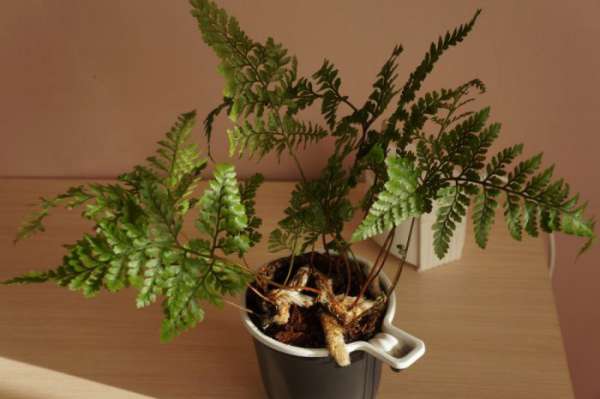

Possible problems when growing davallia fern
In addition to diseases, davallia is prone to the occurrence of some specific problems, which are most often easily solved:
- The fronds dry and darken - too high a temperature, poor or rare watering, sunburn, or excessively dry air.
- The foliage is sluggish or gray-pale - too much sun.
- The leaves dry and turn yellow - excessive dryness of the air, location next to the battery.
- The fronds die off, turning yellow and curling, fresh leaves quickly fall off - too low temperature, location in a draft, cold watering or hard water.
- Few leaves in summer, no splendor - little light or insufficiently loose soil.
- The foliage turns yellow and dries in winter - a normal occurrence during the dormant period, which will end with the arrival of spring.
It will be interesting to watch the video material about the davallia fern, we wish you pleasant viewing.
Like any plant, davallia requires attention and care. However, caring for a plant is quite simple - you just need to create the right conditions and maintain them. With this approach, you can settle the beauty davallia for a long time - the best decoration of an exquisite interior.
Popular varieties
About 60 species grow in nature. Only a few are suitable for growing in an apartment. Often found:
- Davallia Canary. Curly perennials with a straight thickened rhizome. The leaves are pinnate, up to 45 cm, sitting on a straight petiole.Sporangia are formed at the top of the leaf. Can grow in coolness.
- Davallia Tiermani. View with triangular, dissected leaves of a delicate color. The petioles are similar in stiffness and thickness to wire. Thick rhizomes are densely covered with silvery or brown scales. Used as an ampelous plant.
- Davallia is dense. Curly perennial with a thin woody rhizome. The scales are filiform. Three times plumose leaves grow up to half a meter. Petioles are elongated, brown. High decorativeness.
- Davallia is blistered. Decorative deciduous perennial. The rhizome is creeping. Hanging "legs" are abundantly covered with light brown hairs. Leaves are 3-wa, 4-cut, up to 25 cm. The decorativeness of the variety is high.
Important! The davallia fern is unpretentious and hardy. The main conditions for good growth are warmth and humidity. Does not tolerate cold, loves frequent watering and spraying. Some varieties require rather low air temperatures in winter, therefore they are suitable for growing only in winter gardens. It is impossible to create such conditions at home.
Plant species
Of all the known species, there are only a few adapted for growing in a room environment.


Let's take a closer look at these types of davallia:
- Five-leafed - powerful roots. The color of the roots is compared to that of cocoa. The leaves are shiny, the petioles are small. This species is not intended for outdoor cultivation.
- Canary - the plant is native to the Canary Islands. Small roots. A lot of spores are located at the top of the plant. This species tolerates draft and low temperatures well.
- Mariesa - came to us from Japan. In length, no more than 30 centimeters. The leaves are shaped like a feather.
- Dense - native to Australia and Polynesia. Curly in appearance. The plant is perennial, the leaves are pinnate. The roots are thin. Feels good in greenhouses and indoor conditions.
Landing
To plant a plant, you need a shallow but wide flowerpot with a hole in the bottom and a lot of drainage.
Davallia prefers acidic (3 - 5 pH) or slightly acidic (5 - 6 pH) loose nutrient substrates. Use ready-made soil for orchids or epiphytes. You can apply a universal composition of the earthen mixture and add sphagnum moss (2: 1), bark, charcoal, perlite.
When planting, the roots are not buried in the ground, but are placed on the surface by slightly digging into the ground, pinning the rhizome with a paper clip or overlaid with stones so that they do not tip over. Cover the rhizome with damp moss or coconut fiber.
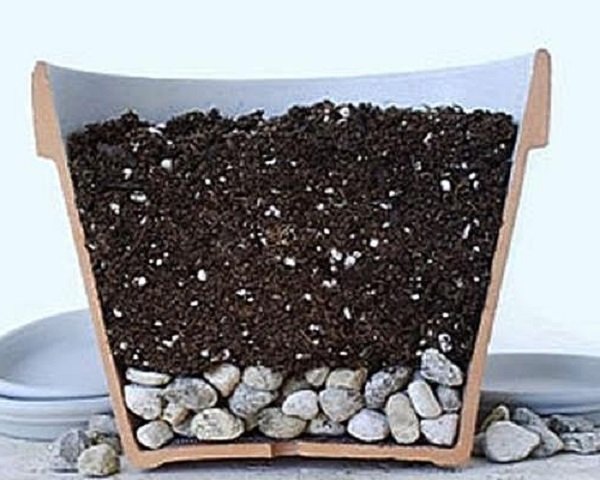

Drainage required for landing
Diseases
Usually davallia starts to hurt due to improper care. Watering the plant too much and too often can cause rot. In this case, the rot is cleaned from the roots and the watering regime is reduced.
Also, davallia can get sick with a fungus. At the initial stage of the disease, the affected parts are necessarily cut off and the wounds are sprinkled with ash. In this case, it is necessary to treat the plant with a special preparation.
The plant can be attacked by various pests - aphids, scale insects, ticks. Pests must first be removed manually or with the help of a shower. Then the plant is treated with special pest control agents.
Davallia will become an unusual and exotic decoration for any apartment. The lush appearance and the roots growing outward will not leave the dawallia unattended. Even the most inexperienced florist can handle the cultivation of a plant.
Useful properties of Davallia
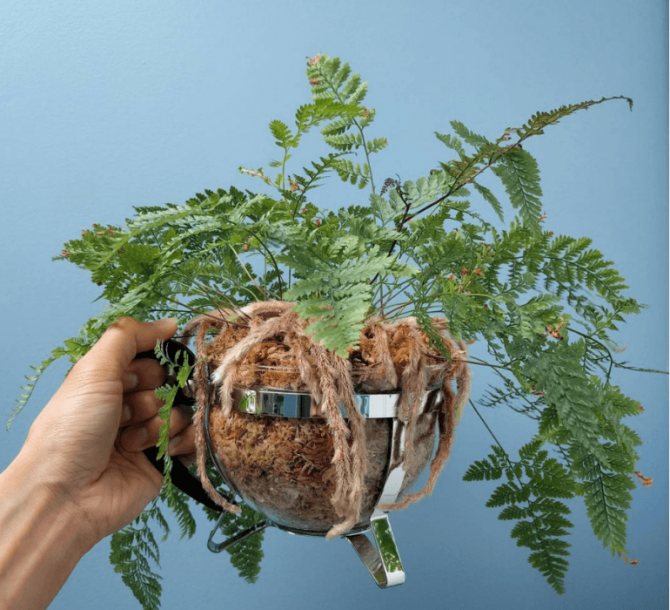

The main beneficial property of the plant is to humidify the indoor air. It filters harmful substances, performing the functions of a "green liver". Davallia fights physical, chemical and biological air pollution. It feeds on gases that are hazardous to human health. The plant has a sound-absorbing effect.
The main difficulties
Pests are very fond of beautiful and delicate fern frond.In addition to a wide range of the most common indoor pests, davallia also has a personal enemy - the fern aphid, which, unlike ordinary aphids, can be black. At the first signs of the presence of insects, the plant must be treated: first with folk remedies (soap, tobacco solution), and if it does not help, then apply insecticides.
Diseases also do not bypass dawallia. The most common are root rot from cold air or water and drafts.
Popular types of dawallia
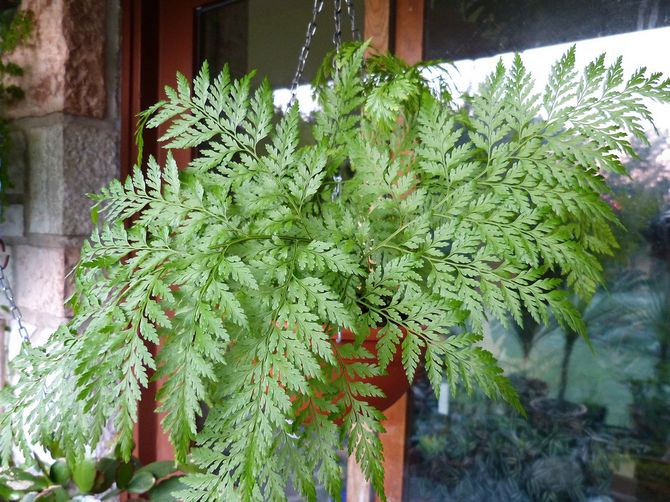

Davallia ordinary (Davalliabulata) - like everything else, a perennial plant. Its leaves have a linear venation, a deep dissection, dentate closer to the top of the leaf edge. His fronds are pinnately dissected three or four times, and their length reaches 20 centimeters, but there are also longer.
Canary davallia (Davalliacanariensis) - is also a perennial climbing plant. Oval, in shape closer to a rhombus, the leaves are serrated and dissected at the edges, and on the plant they are planted tightly to each other. The rather thick and straight root is covered with light scales. The fronds in this species are green, triangular in shape, about 10-20 centimeters longer than in davallia vulgaris, four times pinnately dissected.
Dense davallia (Davalliasolida) - a perennial plant, like the Canary dawallia, winds. She has a leaf with linear venation, finely lobed. Filiform scales cover the thin rhizome. The fronds, just like the Canarian davallia, are 45 centimeters long, green, triangular in shape, but crossed only three times.
Diseases and pests - methods of treatment
Davallia has a stable immunity to diseases. But if the rules of care are violated, fungal infections may occur that occur when the thermal regime is violated, as well as with excessive humidity.
Treatment: immediately replace the soil in the pot, always disinfected. Cut out the affected areas with a sharp sterile knife and treat with a fungicide or at least sprinkle with crushed activated carbon.
Pests inhabiting neighboring plants can be dangerous for the fern, so prevention is a prerequisite for the healthy growth of davallia.
Indoor flowers are recommended to be treated with phyto preparations, they are safer for humans and completely non-toxic to plants, for example, Fitoverm from insects, Fitosporin from fungal spores. They are perfectly combined with each other, enhancing the action.
Remember: after bringing a flower home, put it in "quarantine". Plant in sterile soil. Use disinfected tools. Follow the rules for individual flower care. And then the environment of healthy and beautiful plants will decorate any interior.
Houseplant davallia
The plant is often grown in greenhouses. davallia fine-toothed (D. denticulata), outstretched (D. divaricata), canary, dense (D. solida) and others. Dawallia Maris (D. mariesii) has been known in the culture for many years, found in the wild in Japan. The rhizomes of this fern are exported in large quantities to other countries of the world.
Fleshy rhizomes, densely covered with brown scales, are tied with wire, giving them the shape of a monkey's body. They are then supplied with small porcelain monkey heads and transported in this leafless state for sale. Arriving "monkeys" are hung up in greenhouses or in winter gardens and abundant watering begins, after which leaves soon appear on them.
The main method is reproduction through spores. Sporangia davallia are mixed, on long (4-5 cells in length) legs, without paraphysis. They are equipped with a ring of 11-16 thick-walled cells. So, for example, having got on a suitable substrate, after 6 - 7 days the spores of davallia fine-toothed germinate. Mature gametophytes are thin, elongated, cordate.On the ventral side there are unicellular rhizoids, soft, colorless at first, brown with age. Antheridia appear at or near the edge of the gametophyte. They become noticeable at the age of three months. Archegonias appear on the ventral side two weeks after the appearance of antheridia. The development of the embryo begins 3-5 days after fertilization.
Ferns of the subfamily Davalliaceae have long creeping dorsiventral rhizomes. On their upper side, leaves are located in two rows at a considerable distance from each other. Fleshy, finger-thick, densely covered with reddish scales, rhizomes are able to store some water in their tissues. The conducting system of all davallievs is dictyostelic, but there are a number of types of steles that deviate from the usual dictyostels. They arose in connection with the dorsiventrality of the rhizomes.
The leaves of the fern species in the subfamily are pinnately dissected, but in some humat species the leaf blade is whole. Pubescence, as a rule, is clearly visible on young leaves; with age, it can persist, but more often disappears. The leaf stalks are articulated with special outgrowths of the rhizome - phyllopodia. The presence of an articulation between the leaf and the rhizome plays an important role in the life of the davallievs. Due to this property, davalliums are deciduous. The replacement of old leaves with new ones occurs by alternately, and in some cases, simultaneous dropping of all leaves. The latter is especially important for plants living in countries with seasonal climates. Some dawallia shed their leaves with the onset of the dry season and, as such, wait for the onset of new rains.
Articulated leaves are quite rare, but not unique among ferns; they are present in a number of species from polypodia and aspenia. However, the anatomical structure of the petiole at the border of the articulation and the method of forming the separating layer are different in davalliaceae and polypodiaceae.
Due to their deciduous nature and fleshy, water-storing rhizomes, davalliaceae easily tolerate significant drought. Almost all species of this family are epiphytes of the upper layer of the forest. Davallia crynate sometimes lives on other light-loving epiphytic ferns, in particular on some species of Platycerium.
Houseplants davallia are epiphytic ferns with a thick rhizome, covered with dense pubescence and spread over the surface of the substrate. Often the fluffy roots of davallia twine around the outside of the entire pot and hang down, along with the leaves of young rosettes that appear in abundance on the roots. This fern looks very decorative in an ampel. Most types of davallia have triangular vai, pinnately dissected, openwork and airy.
Most often they are used as ampelous plants and are grown in baskets or hanging pots.
The plant gets its name from the hairy, hairy, silvery roots that hang from the pot. Green fine-feathery openwork fern leaves have earned well-deserved fame for this plant among flower growers.
Look at the davallii in the photo, which shows the most different types and varieties of fern.
Botanical reference
The davallia fern is an epiphyte and a lithophyte, in the wild it lives on tree trunks or in rock crevices, but you can find it, though very rarely, and growing on the ground. Natural stay - warm and temperate zones of North America, tropical jungles of Asia, Australia, the islands of the Caribbean and Polynesia. Its dimensions are enormous, up to 1 meter high and 1.5 meters in volume.
On the territory, dawallia is grown in greenhouses, conservatories and in indoor conditions, where the size of the bush reaches a maximum of 45 cm.
The plant is named in honor of the discoverer of the Davallia genus, Edmond Daval (1763 - 1798), a Swiss botanist.The genus is represented by perennial evergreen, semi-deciduous or deciduous ferns, which are part of the Davalliaceae family.
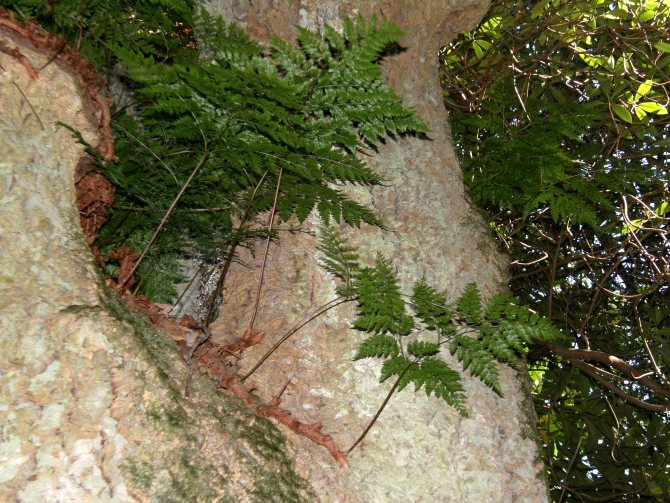

Fern in the wild
A feature of the plant is the root system: a branched rhizome, covered with scales at the base of a copper or gray color. Growing quickly over the surface, the roots are covered with a shaggy pile and leave the pot.
The originality of the rhizome gave rise to various popular names for the flower: hare, spider or squirrel legs, deer leg, emphasizing its popularity.
It is not necessary to remove or trim these "legs" if they are healthy - the plant accumulates moisture from the air in them, they participate in air exchange and photosynthesis. In the wild, with these hairy roots, davallia clings to the surface of the wearer.
The fluffy openwork crown consists of rare leaves on thin low triangular petioles, they are called frond in ferns. Unlike other ferns, fronds do not come out of the outlet, but from the rhizome (modified stem, creeping on the surface), separately, singly, located at a distance from each other on its upper side. From below, the root releases thin roots into the soil.
Leafy broadly ovoid plate strongly dissected (doubly pinnate), leathery, consists of numerous elongated fragments with a serrated edge, juicy green in color.
Pests
Succulent fern frond attract many pests. On davalliya you can find:
- whiteflies - small light-colored butterflies whose larvae feed on plant sap;
- spider mites - microscopic parasites that entangle davallia with tiny cobwebs;
- scale insects that look like numerous plaques on the leaves;
- aphids - small pests that form large colonies and feed on the sap of the victim;
- thrips - small flying insects of nondescript color;
- mealybugs - aphids with a long body, as if sprinkled with flour.





